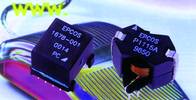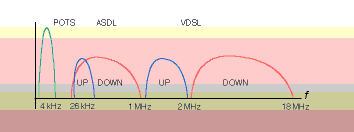
Transmission speeds of around 100 Kbps will probably no longer suffice to satisfy the needs of our communication society. Only a short while ago this was still seen as the recommended speed on the data superhighway. In the meantime, however, the call for higher data rates is becoming increasingly louder and some systems to end-users have already exceeded the megabit limit. Are such high data rates really necessary?
Advanced ferrite materials for low-distortion transmission at high speeds
At 5 Mbps, moving images can be observed on-line without jerkiness. At 64 Kbps, ISDN requires some 10 minutes to download the latest generation of browsers such as Netscape Navigator or Windows Explorer. The same process takes only 30 s at a speed of 2 Mbps. Since the software is growing more complex all the time and programs are becoming ever longer, the Internet boom is creating strong pressure to achieve even faster access times. Services such as video on demand, home shopping, infotainment and video conferencing obviously require higher speeds too. EPCOS already offers suitable products, ferrites and inductors for these applications (Figure 1), designed for high data rates and equipped with the extra features needed for broadband communications.

The aims have been defined, and it only remains to implement them. One of the fundamental problems in increasing data rates is what is known as the 'last mile', namely the route which connects the end-user to his nearest distribution point. From today's perspective, the most promising solutions for bridging this gap at high speeds are BK-networks, mobile phones, Powerline and xDSL.
xDSL
The xDSL (digital subscriber line) technology runs on the existing copper cables currently used for conventional fixed-network telephony and offers very high availability here too. Some of its most widespread variants are shown in Table 1.

ADSL is the most important representative of this transmission technology because asymmetrical transmission is customized to the end-user's Internet access. At first sight it seems impossible to suddenly increase the transmission speed a hundred-fold over the same telephone line by means of ADSL. The trick lies in the broadband capability and the encoding technique known as DMT. The ADSL frequency spectrum is shown in Figure 2. It can be seen that the frequency band extends up to 1 MHz instead of only 4 kHz as in conventional telephony, or 132 kHz with ISDN. However, the line capacitance causes the efficiency of the transmission to decline with increasing frequency and distance. In order to implement high bit rates despite this limitation, the data is encoded via DMT onto 256 channels which 'transmit' simultaneously. This naturally presupposes that the 'transmitters' do not disturb each other, just like in radio technology. Such disturbances occur if distortions along the transmission route lead to the generation of harmonics.

Requirements on ferrites
Against this background, the requirements for ferrite inductors are clear. Firstly, high-pass/low-pass filters are needed to implement splitters between the voice band (low frequencies) and the data band (high frequencies). They not only suppress noise in both bands but even allow a telephone conversation to be held while the computer modem is in use! Secondly, impedance matching and insulation are implemented with ferrite transformers which must have an extremely low distortion factor. If this is not ensured, the transmission speed suffers considerably.
Design optimisation
The distortion factor was already recognised as a problem at the very beginning of xDSL development. The demand for low-distortion ferrite materials led to EPCOS developing a completely new generation of these materials which is unique on the world market. Although existing products were already available for these applications at that time, there was a lack of guidelines for optimising their design. Now, however, EPCOS offers not only extensive technical information but also a specially set-up menu in the new version of its magnetic design tools, available free from EPCOS.
Since these relationships are now understood, the product range of xDSL transformers has been optimised. Firstly, material parameters such as the temperature-dependent hysteresis material constant hB(T) were improved either by redesigns (N26, T33) or entirely new designs (T55). Secondly, the core shapes were characterised by the core distortion factor (CDF). In addition, standardisation was achieved for the critical design parameter, the AL value, and optimal tolerances were simultaneously defined. In addition to pure ferrite cores, EPCOS also offers complete inductors. The range extends from standard interface transformers up to customised solutions such as connectorised inductors for splitters.
High requirements with VDSL
VDSL is a relatively new variant of xDSL. It is often presented as the next generation of ADSL. A way was originally sought to bridge the last meter up to the end-user in broadband communications, with FTTC (fibre to the curb) TV signals being thought of. Now VDSL even offers the option of transmitting HDTV with data rates of up to 55 Mbps (downstream). This high bandwidth is naturally obtained at the expense of the range, so that only about 300 m can be bridged at the full downstream rate. Nevertheless, the range can already be extended with a somewhat reduced data rate and further extensions will certainly be achieved in the future. In general, VDSL is comparable to ADSL. Voice and data signals are again transmitted in separate frequency ranges. This means that splitters and thus inductors are required once more. The two systems are distinguished essentially by the frequency range of their applications. VDSL makes tough demands on the components and thus also on the ferrite materials at frequencies up to about 18 MHz.
The broadband capability of the transformers needed for this purpose depends essentially on their configuration (the AL value or effective permeability µe, winding design). Small-signal losses also play a part in selecting the material in the form of the parallel conductivity gp. This parameter has recently been introduced by EPCOS. It represents the material component of the transformer's parallel resistance and co-determines its operating attenuation. The frequency response of gp can be represented in the new Magnetic Design Tool for all materials and is independent of the resonance characteristic of the material. This is of particular interest in view of the fact that the resonance frequency of the MnZn ferrites suitable for these applications lies far below the upper VDSL frequency band.
Further developments
The various access technologies all have specific advantages and drawbacks. However, one thing does seem certain at the moment: the booming Internet market will make it easier for the various providers to invest the sums needed to upgrade the infrastructure. It will still be a while before the dominant position of the analog modem will really be broken. Thus, analog modems and ISDN accesses will still make up around 75% of all Internet accesses in Europe even in the year 2003.
However, there is no stopping the broader-band access technologies. The share of DSL in Europe will rise from a current 0,1 to 11,4% in the year 2003. Significant growth can also be observed in the US. Thus the number of installed lines there will grow from the present 500 000 to almost 10 million in the year 2003.
As one of the leading manufacturers of ferrites and inductors worldwide for telecommunications, automotive, industrial and consumer electronics, EPCOS will continue to keep pace with technological developments in future and will offer its customers innovative ferrites and inductors.
| Tel: | +27 11 458 9000 |
| Email: | [email protected] |
| www: | www.electrocomp.co.za |
| Articles: | More information and articles about Electrocomp |

© Technews Publishing (Pty) Ltd | All Rights Reserved